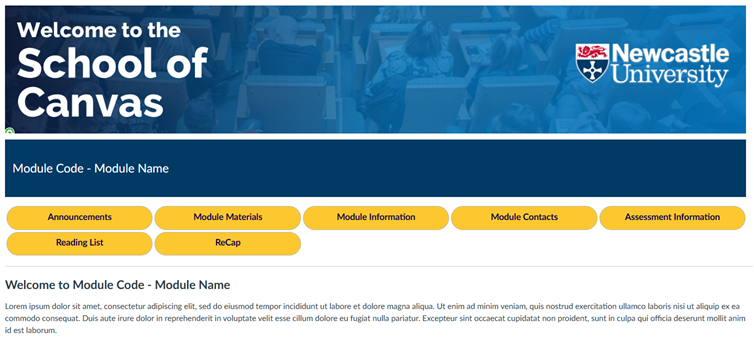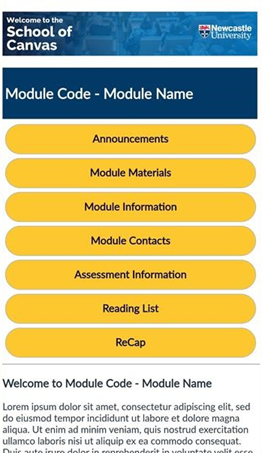Canvas Course Release and Template Updates 2025-26
NEW: A vision for education and skills at Newcastle University: Education for Life 2030+
Canvas Course Release Schedule
The Canvas course creation process for Academic Year 2025-26 will be the same as last year, with the only change coming in a new design. Courses are now created in June and will start to appear on your dashboard from W/C 30 June 2025 (in the "Unpublished" area). Any colleague listed on a MOF will automatically be given Teacher access to the respective Canvas course. Colleagues not listed on the MOF can be added manually by your School Office.
If you have any queries about the course creation process, you can contact ltds@newcastle.ac.uk.
Homepage Updates
Following consultations with student focus groups and the analysis of survey data from both students and staff, we are pleased to announce forthcoming updates to the Canvas Blueprint Homepages. These modifications are designed to enhance its navigability, personalisation, and overall usability.
Homepage Improvements
Designed to Work on More Devices
Based on insights from Instructure, the makers of Canvas, we have learned that many of our students use the Canvas mobile application on Android and Apple devices. To enhance their experience, we have redesigned the interface to be more effective across various devices, especially mobile ones.
Button Based Navigation
One significant change is the replacement of the tiled image links at the bottom of the homepage with a new button-based approach. These buttons are now neatly displayed at the top of the screen, providing students with quick access to key links. This redesign not only improves navigation by reducing the need to scroll to find important links but also enhances performance.
The slow-loading images have been replaced with faster-loading buttons, which is particularly beneficial for students using Canvas on low data connections, such as mobile networks.
These new buttons are designed to be fully responsive, ensuring they display and align perfectly across all devices and screen sizes. Whether you're using a smartphone, tablet, or desktop, the buttons will adapt seamlessly to provide a consistent and user-friendly experience.
View in Canvas Desktop

View in Canvas Mobile Application

New Banner Image - Consistency Across All Courses
We have created a consistent banner image to be used across all courses. This banner will be personalised with the title of the school the module belongs to, but maintaining the same design provides a level of consistency for students accessing courses. Students have told us in focus groups about the importance of a consistent look and design, highlighting how it helps them feel more comfortable and familiar with their course environment.

New Homepage Navigation Links

After consulting with student focus groups about Canvas course design, we identified key links and resources. We asked students what they accessed most frequently and what they considered most important. These insights helped shape the design of the new navigation links on both the homepage.
Here is the rationale behind the homepage navigation choice. This is based on insights from student focus groups and best practice guidance (e.g. Canvas Baseline):
Announcements
Canvas Announcements are a key communication tool within your courses. While they are displayed on the homepage in the desktop view of Canvas, they are not visible in the Canvas mobile application. To ensure quick access to announcements, we've added a new button on the homepage.
To learn more about Canvas Announcements and how to use them in your course, please visit the Canvas Announcements.
Using Canvas Announcements in your courses help with meeting the "Beyond the Baseline" standard, as laid out in the Canvas Baseline guidance.
Modules Materials
From our focus groups, students informed us that Canvas Modules are widely accessed. They are used in courses for storing and organising teaching content. Given the importance of Canvas Modules, the "Module Materials" link from previous Canvas designs will remain unchanged.
To learn more about Canvas Modules and how you can use them in your courses.
Using Modules in Canvas to create an easily navigable course structure, assists with making learning materials easily found help with meeting the Canvas Baseline requirements (Baseline Requirement #5).
Modules Information
Important module information, such as credit weighting, learning outcomes, and a summary of teaching activities, should be easy to find and understand within the Canvas course. This information can be provided either via a module handbook or by linking to the syllabus section of the Canvas course. Providing this information upfront helps students know what is expected, how to seek assistance, and how their progress will be evaluated.
It promotes transparency and empowers students to engage actively in their learning journey.
Making important module information easily accessible is a Canvas Baseline requirement (Baseline Requirement #2).
Modules Contacts
Key module contact information, including details for teaching staff, should be easy to find within the Canvas course. This accessibility allows students to easily reach out with questions, concerns, or for additional support, promoting a collaborative and interactive learning environment. It enables students to seek clarifications, engage in meaningful discussions, and receive timely feedback on their progress. Immediate access to key staff contacts helps students feel supported and valued, fostering a sense of belonging within the academic community.
Making module contact information should be easily accessible is a Canvas Baseline requirement (Baseline Requirement #3).
Assessment Information
Assessment information should be clear and easily accessible, including instructions, deadlines, weighting, rubrics or marking schemes, and feedback availability. Students have reported in focus groups how important easily accessible assessment information is. This clarity ensures students understand the expectations, requirements, and evaluation criteria for each task. It also aids effective time management by providing clear deadlines and weighting information, allowing students to prioritise their efforts and avoid last-minute rushes. Additionally, accessible rubrics or marking schemes enable students to align their work with desired standards and make targeted improvements.
Clear and easily accessible assessment information is a Canvas Baseline requirement (Baseline Requirement #7).
Reading List
By providing a Course Reading List on Canvas, instructors enable students to conveniently access and engage with the necessary readings via a direct link. Students have stated in focus groups that they use this function regularly. This helps students stay organised, plan their study time effectively, and engage in critical analysis and discussions related to the course materials.
Using Modules in Canvas to create an easily navigable course structure is a Canvas Baseline requirement (Baseline Requirement #5).
Recap
Students often use Canvas to access lecture recordings. Recognising the importance of these resources, we've made it easier to find them. We've added a new section on the homepage explaining how ReCap is used in the course and detailing any alternative resources available when ReCaps aren't provided. Additionally, we've added a new ReCap button on the homepage and moved the ReCap link higher in the course navigation order for better accessibility on mobile devices.
Offering ReCap recordings significantly benefits students, especially those for whom English is not their first language, and those with Student Support Plans (SSPs). Additionally, providing content in multiple formats, such as captioned lectures, ensures that all students can access and engage with the material in ways that best suit their needs.
New School Links Section
A new school links section has been created to allow schools to add custom links to resources that would be useful to their students. These links could include specific school policies, Canvas communities, or other valuable information.
Unlike the previous Navigation Tiles, these links are easily customisable using the Canvas Rich Content Editor, requiring no knowledge of HTML.

Useful Resources Links
A new Useful Links section has been created to enable you to add custom links to resources that will benefit your students. We have included some standard links to essential resources, such as the How to Use Canvas Course, the Academic Skills Kit Website, and the Artificial Intelligence and Your Learning Website. To maintain consistency across Canvas courses, these links should be preserved, and any additional links should be added below them.
Unlike the previous Navigation Tiles, these links are easily customisable using the Canvas Rich Content Editor, requiring no HTML knowledge.

School Contact Details Footer
We have included a footer with contact details for your school office, providing students with quick and easy access to important contact information. This footer ensures that students can effortlessly reach out for assistance or inquiries, enhancing their overall experience and support.

